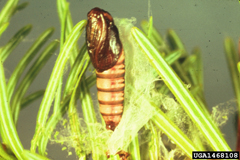Common Name
Eastern Spruce Budworm
Latin Name
Choristenaura fumiferana
Order
Lepidoptera
Family
Tortricidae
Main Host(s): Balsam Fir (Abies balsamea), White Spruce, Black Spruce, Red Spruce (Picea spp.)
Life Cycle
The Eastern Spruce Budworm produces one generation per year, and prefers to feed on Balsam fir, although White, Red, and Black Spruce are all suitable hosts. Occasionally, but rarely, heavy feeding occurs on Hemlock, Pine, and Larch.
After overwintering, budworm caterpillars emerge in the spring to mine flower buds and older needles. As they grow older and larger, they move to the ends of branches and bore into vegetative buds. They will often web three or more shoots together to form a protective shelter. As they mature and progress through their various instars they become free feeders, preferring new foliage. At this time the black-headed caterpillars are dark brown with light dots along their backs and about 1 inch (2.5 cm) in length.
Pupation occurs from mid-July to early August, usually at twig crotches or in webbing near branch tips. Pupae are reddish to light brown with darker bands and spots. After about 12 days, they hatch into a small brown-grey moth, with a wingspan of ¾-1 inch. (2 – 2.5 cm).
Female moths lay light-green eggs on the flat surfaces of fir and spruce needles near the tips of branches in July and August. Eggs are laid in masses of about 20, with the eggs overlapping like shingles. Each female lays about 200 eggs. Eggs hatch within 8 to 12 days, and the small caterpillars disperse on the branches, where they molt once before hibernating under the bark scales on small twigs of the host trees.

Impact & Damage
Extensive defoliation can cause significant impacts on individual tree and forest health. As with many defoliators, even one year of defoliation can cause a reduction in growth and yield. Several years of defoliation can cause significant tree and stand mortality.
Recommended Control
Depending on your program’s operational need, either Foray or Mimic are effective controls for Eastern Spruce Budworm.

Resources
Learn more about Eastern Spruce Budworm
Quick Links
Contact a Valent BioSciences public health representative.
Contact Us